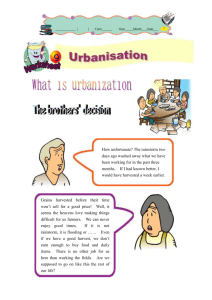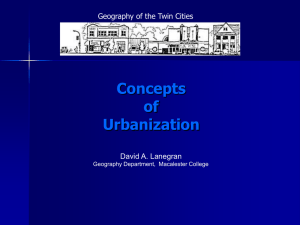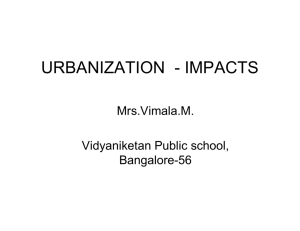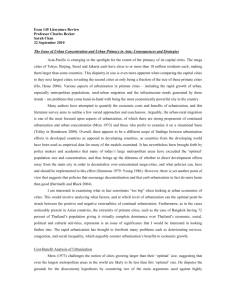Chapter 13 Part 2
advertisement
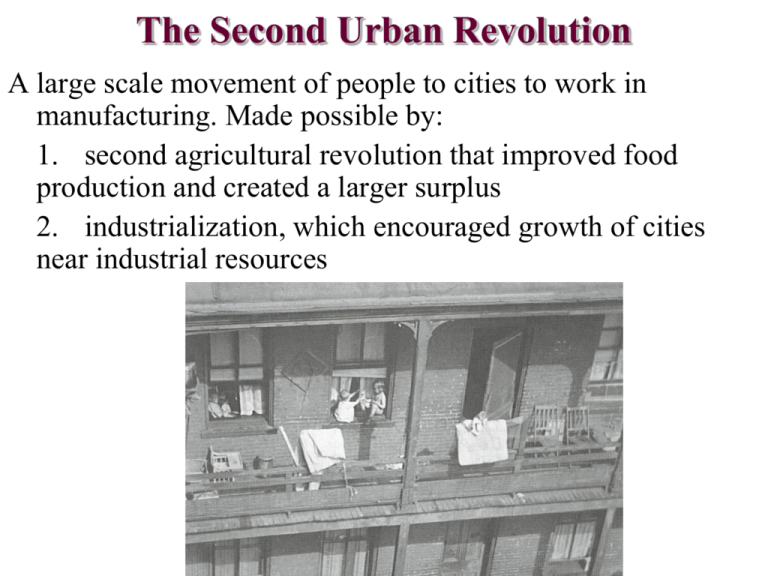
The Second Urban Revolution A large scale movement of people to cities to work in manufacturing. Made possible by: 1. second agricultural revolution that improved food production and created a larger surplus 2. industrialization, which encouraged growth of cities near industrial resources The Modern Western City • Manufacturing city first developed in Britain, later Western Europe and North America. • Rapidly growing factory system with railroads and tenement slums • Sanitary systems, water supplies and housing were overwhelmed with rapid growth and pollution. The Modern Western City • Modernization of American cities took place in late 19th cent. • Electric trolley and other forms of mass transportation transformed cities-transport systems became circumferential and radial. • Suburbanization of the city became possible with 1920s revolution of the automobile • Modern cities of North America are sprawling expanses of suburbs, shopping malls and business parks • Hinterland-a German word that means land behind the city • Spacing of cities-large cities lie farther apartsmaller settlements are closer to each other • Industrial Revolution began in Europe-arrived in the US around 1870-in only 50 yrs. US surpassed Europe • 25 million European immigrants arrived in America-many in manufacturing centers John Borchert’s “American Metropolitan Evolution”-4 Stage model of evolution • First Stage-SailWagon Epoch (1790-1830) slow, primitive overland and waterway transport-Boston, New York and Philadelphia were major cities oriented to European trade. John Borchert’s “American Metropolitan Evolution-4 Stage model of evolution • Second Stage-Iron Horse Epoch (1830-1870) Diffusion of steam-powered railroads-coal mining-boomed, tracks laid coast to coastmanufacturing spread outward from New England hearth-by 1850 New York was primate city with Pittsburgh, Detroit & Chicago growing rapidly • Third Stage-Steel-Rail Epoch (1870-1920) coincided with the Industrial Revolution Steel industry in Chicago, Detroit & Pittsburgh Coal & iron ore supply areasnorthern Appalachia and Lake Superior (Mesabi) Agglomeration in raw materials and market location due to railroad. Steel replaced iron rails-safer-more powerful locomotives-larger freight cars & even refrigerated cars added. • Fourth Stage-Auto-AirAmenity Epoch (19201970) Gasoline-powered internal combustion engines-truck based regional and metropolitan distribution of goods; increased automation of blue-collar jobs; shift to white-collar jobs; highways, expressways and jet aircraft made travel faster & cheaper; amenities of suburbs, Sunbelt; New activities responded less to cost-distance factors • Fifth Stage?- (1970Now) decline of Rust belt continues; high tech. will stimulate an even greater dispersal of city populations; telecommuting, working from home, globalization and outsourcing change the way we work Urbanization and Location • 1800-despite Ind. Rev. Europe was still rural-by 1950 Europe was 50% urban-today 85% urban • World today is 50% urban • Agglomerationclustering of industries for mutual benefit • Specialization-certain industries dominate certain regionsManchester textiles, Pittsburgh, Pa. steel • Urban Geographers look at: – – – – How cities are arranged What cities look like Transport & communications Why people move from place to place within the city • Hinterland: the surrounding service area of a city that includes smaller villages and hamlets • Centrality: the economic power or draw of a place compared to its competition • Hamlet-small collection of houses-may have services. • Village-several dozen services-stores, gas stations and so forth • Town-larger than a village-higher level of specialization-banks, schools, libraries, specialized stores-furniture, appliances, hardware, etc. • City-more functional specialization-larger hinterland, greater centrality, well defined CBD and suburbs • Metropolis or Metropolitan area-urban area larger than a city • Megalopolis-when large metropolises coalesce into a megacity, e.g. Boston to New York Site and Situation Site * absolute location of a city * a city’s static location, often chosen for trade, defense, or religion. Situation * relative location of a city * a city’s place in the region and the world around it. • Chicagosituational advantage-Great Lakes & Mississippi water complex junction; west end of the industrial core; next to vast, rich farmland; location of rail, road, water (St. Lawrence Seaway 1959) & air route junction; major natural resource hinterland • Guangdong Province-southern China; city of Shenzen-3 million, 30 yrs ago only 20,000 • Urban situationproximity to Hong Kong & status as Special Economic Zone • Its relative location has enabled it to benefit from trade & commerce • Situations can deteriorate: • Cities of Northeast Manufacturing (Rustbelt) in decline • Brugge, Belgium-declined in size after river silted up. • Berlin, Germany destroyed in WWII and divided during the Cold War • Many rural towns were bypassed by expresswayswithered and died. • As cars replaced horse & buggy, many rural hamlets, & villages declined • Urban site-the physical qualities of the placeplain, valley, plateau, island, etc. • Singapore-ideal location on an island-an “Economic Tiger” • Bangkok, Thailandcapital on delta of Chao Phraya river-subsidence & air pollution • Mexico City-2nd largest city-basin, flanked by mts. Subsidence, earthquakes, rapid growth and pollution. Modern Urbanization Highest level of Urbanization-Western Europe, North America, Japan & Australia 70% & higher-Mexico, Cuba, France Former Soviet Union-Russia-73%, Ukraine-70%, Transcaucasus-55%, Central Asia-28% South America-cone of Argentina, Chile & Uruguay-highest urbanization-next Brazil & Venezuela, Paraguay, Bolivia, Guyana, Suriname & French Guiana lag behind. Sub-Saharan Africa-some of the world’s lowest urbanization rates-Nigeria-16%, Ethiopia, Rwanda, Burundi & Uganda are even lower. Tropical Africa-only a few nations that are 40% or higher-South Africa-57% due to mining and industry. Modern Urbanization Southwest Asia-North Africa-great variety of urbanization. Much of Middle East, esp. Arabian Peninsula are highly urbanized due to nucleation of the oil industry. Jordan an exception-no oil wealth-but urban due to long tradition Southern Arabia is oil poor and rural Contrast-oil rich Libya is urban, oil poor Afghanistan is rural Modern Urbanization South Asia-low in urbanization, despite huge cities like Mumbai and Calcutta Most nations in South Asia are under 30% urban India-26% Pakistan-28% Bangladesh-16% Subsistence farming dominates life here Modern Urbanization Southeast Asia- Singapore is the only 100% urban state Brunei & Malaysia are the only other nations with over 50% urban Indonesia-31% Myanmar-25% Vietnam-20% Thailand-19% Subsistence farming dominates life here Modern Urbanization East Asia- Averages 36% Only Japan, South Korea and Taiwan are highly urbanized in East Asia China below-25% Yet Shanghai & Beijing Have 25 million between Them, however most of China’s 1.2 m. are rural Great Cities • North America-several megalopolitan regions:Boston-Washington, DC – – – – Chicago-Detroit-Pittsburgh San Francisco-Los Angeles-San Diego Montreal-Toronto-Windsor Miami-Fort Lauderdale-West Palm Beach • Europe: – London-20 m. in Metro area – Germany-Ruhr, Rhine zone of Dusseldorf-Essen & Cologne – Poland-Saxony & Silesia – Also Moscow, St. Petersburg & Madrid-not yet multi cities, but growing
